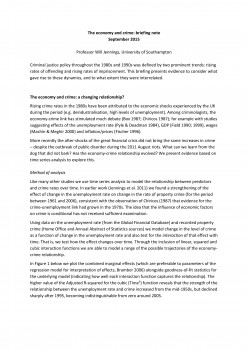The economy and crime: Briefing note
In this note, written to coincide with the What shapes trends in crime? event on 18 September 2015, Professor Will Jennings of the University of Southampton examines the links between economic trends and the official crime rate.

The paper argues that the association between unemployment and property crime – which was strong in the 1970s and 1980s – weakened after 1995 and became non-existent by 2005.
The relationship between unemployment and property crime rates became stronger during the 1970s and 1980s, peaking around 1995. It then declined, becoming non-existent by 2005.
This helps to shed light on why the official crime rate did not rise following the 2007-2008 financial crisis.
Commenting on his briefing note, Professor Will Jennings says:
‘Changes in the labour market may have dampened some of the effects of recent economic downturns.
‘Compared to the 1980s, when whole industries and communities were affected, recent economic downturns have not led to the same levels of unemployment. This means that unemployment rates are no longer such a good indicator of the social and economic strain that society is under, and therefore of crime rates.
‘Developments such as zero hours contracts effectively remove people from the unemployment statistics, which alters the relationship between the official rate of unemployment and recorded crime.’
The analysis has been produced by a team of researchers from the Universities of Sheffield, Southampton and SciencesPo in Paris as part of a project funded by Economic and Social Research Council (ESRC): Long-term trajectories of crime in the UK.